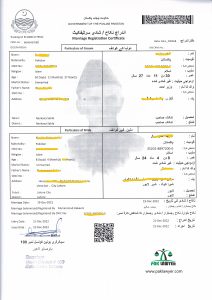Divorce procedure in Pakistan
The divorce procedure in Pakistan for husbands is a comprehensive process involving several detailed steps:
1. Initiation of Divorce Deed: The husband initiates the divorce proceedings by formally executing a divorce deed on stamp paper valued at Rs.300. This crucial document serves as a legally binding pronouncement of divorce in written form, with the husband expressing his intent to divorce his wife. Collaboration with a qualified lawyer is often sought to ensure the legal validity and comprehensive preparation of this document.
2. Dispatching Documents to Wife: Upon completion of the divorce deed, the husband proceeds to dispatch the original document to his wife. Accompanying the divorce deed, a copy of the divorce notice addressed to the Concerned Union Council is included. This copy of notice serves the dual purpose of informing the wife about the imminent divorce and providing information regarding the initiation of divorce proceedings in relevant Union Council.
3. Notice to Arbitration Council: The husband is obligated to formally notify the relevant Union Council/Arbitration Council in writing of his pronouncement of divorce upon his wife. This written communication includes a notice accompanied by a copy of the divorce deed, the Nikah Nama (marriage certificate), and a copy of the husband’s ID card. The Union Council or Arbitration Council assumes a pivotal role in overseeing the divorce proceedings, ensuring that all legal requirements are met during the course of the divorce.
4. Issuance of Reconciliation Notices: Upon receiving the Notice, the Arbitration Council issues formal notices to both the husband and wife, summoning them to attend reconciliation proceedings. These notices indicate the date, time, and venue for the reconciliation sessions.
5. Participation in Reconciliation Proceedings: Both parties involved in the divorce are given the option to attend the reconciliation proceedings either in person or through appointed representatives, such as family members or legal representatives. The objective of these sessions is to explore the possibility of resolving marital issues and preventing the divorce.
6. 90-Days Waiting Period: If reconciliation efforts prove unsuccessful, the Arbitration Council is bound to issue a divorce certificate. However, before the issuance of the certificate, a mandatory waiting period of 90 days must transpire. This waiting period is calculated from the date of the initial notice sent to the concerned Chairman of the Arbitration Council.
7. Divorce Certificate Issuance: After the completion of the 90-day waiting period, and in the absence of successful reconciliation, the Arbitration Council formally issues the divorce certificate. This certificate serves as legal documentation of the dissolution of the marriage.
8. Incorporation of Divorce in Nadra: The divorce certificate is issued following approval from the NADRA database. Upon receiving authorization from the NADRA system, the Union Council promptly issues the certificate, finalizing the documentation of the divorce proceedings. This ensures that the certificate aligns with and is officially recognized by the authoritative NADRA database, providing an accurate record of the divorce. However, it is imperative for both parties involved in the divorce to individually update their CNIC (Computerized National Identity Card) record or FRC (Family Registration Certificate) record at a NADRA office. This update is facilitated by presenting the issued Divorce Certificate to the NADRA authorities. This ensures that the divorce information is accurately reflected in the official records maintained by NADRA for each party.
This detailed process ensures that divorce in Pakistan is conducted in a systematic and legally sound manner, with provisions for reconciliation efforts and a mandatory waiting period to allow for careful consideration before finalizing the divorce. The divorce process for husbands in Pakistan is entirely distinct from the divorce procedure for wives in the Family Court.
For additional information, please visit our YouTube Channel.


Write a comment: